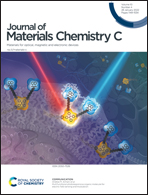An all-inorganic CsPbBr3/GaN hetero-structure for a near UV to green band photodetector†
Abstract
Perovskites are promising candidates for photodetectors because of their excellent optical absorption coefficient and long carrier transportation length. However, most perovskites face the great challenge of instability and narrow band response. Herein, we report a stable all-inorganic perovskite CsPbBr3/GaN heterojunction photodetector which exhibits a sensitive response to the radiation from the near UV band to the green band, thanks to the large optical absorption coefficient of CsPbBr3 and the effective interfacial charge transfer of the heterojunction. The heterojunction operates in both photoconductive and depletion modes. Under a reverse bias voltage, the device can be regarded as a photovoltaic-type photodetector with a responsivity of 82 mA W−1, a detectivity of 9.06 × 1012 Jones, and extremely fast response speeds (rise time of 66 ns and decay time of 20 μs). In contrast, under a forward bias voltage, the device works in photoconductive mode with a much higher responsivity of 1.78 A W−1, an external quantum efficiency of 420%, a detectivity of 6.5 × 1013 Jones, and slower response speeds (rise time of 13.5 s and decay time of 2.7 s). Our investigations demonstrate the dual-mode light-harvesting capability of the CsPbBr3/GaN photodetector and may pave a pathway towards next-generation perovskite optoelectronic devices.



 Please wait while we load your content...
Please wait while we load your content...